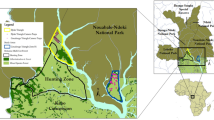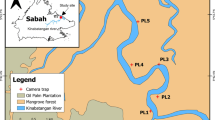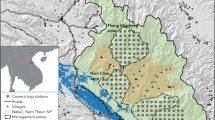Abstract
More than 51% of Bhutan is in a protected area (PA) network and our study demonstrates its effectiveness in conserving large and medium mammal species. We conducted camera trapping in Bhutan’s PAs, biological corridors (BCs) and intervening non-protected areas (NPAs) to investigate the richness and diversity of mammals, and assess the network’s efficacy in protecting mammals. 1858 camera traps were deployed within 1129 5-km × 5-km grids over 536 days between 2014 and 2015, resulting in 148,598 trap-nights (mean = 80 traps-nights/camera) which yielded nearly 10 million photos (mean = 5368 photos/camera trap). Fifty-six mammal species (65% of Bhutan’s 86 medium and large terrestrial mammal species) representing 18 families within seven orders were identified, of which, 18 (32.16%) are listed as threatened by the International Union for Conservation of Nature. There was a significant difference in mammal diversity between PAs, BCs, and NPAs (PERMANOVA test; p < 0.001; Pseudo-F = 6.40; unique perms = 9921), with the strongest difference between PAs and NPAs. Additionally, Hill’s numbers q = 0 (species richness), q = 1 (Shannon’s entropy index) and q = 2 (Simpson’s concentration index) revealed a higher mammal diversity in PAs compared to BCs and NPAs. Higher mammal diversity in PAs can be attributed to the added presence of threatened species, including the tiger Panthera tigris, red panda Ailurus fulgens, Asian elephant Elephas maximus, and golden langur Trachypithecus geei. However, BCs and NPAs share similar patterns of mammal diversity, and globally threatened species such as the Chinese pangolin Manis pentadactyla and Indian pangolin Manis crassicaudata were only detected in NPAs. Although Bhutan’s PA network is effective in conserving much of the country’s mammal diversity, realignment of some protected areas and biological corridors would ensure the long-term protection of several threatened mammal species.






Similar content being viewed by others
References
Aung SS, Shwe NM, Frechette J, Grindley M, Connette G (2017) Surveys in southern Myanmar indicate global importance for tigers and biodiversity. Oryx 51:13
Bruggeman D, Meyfroidt P, Lambin EF (2016) Forest cover changes in Bhutan: revisiting the forest transition. Appl Geogr 67:49–66
Bruggeman D, Meyfroidt P, Lambin EF (2018) Impact of land-use zoning for forest protection and production on forest cover changes in Bhutan. Appl Geogr 96:153–165
Büscher B et al (2017) Half-Earth or Whole Earth? Radical ideas for conservation, and their implications. Oryx 51:407–410
Ceballos G, Ehrlich PR (2002) Mammal population losses and the extinction crisis. Science 296:904–907
Chao A, Jost L (2012) Coverage-based rarefaction and extrapolation: standardizing samples by completeness rather than size. Ecology 93:2533–2547
Chao A, Gotelli NJ, Hsieh T, Sander EL, Ma K, Colwell RK, Ellison AM (2014) Rarefaction and extrapolation with Hill numbers: a framework for sampling and estimation in species diversity studies. Ecol Monogr 84:45–67
Chettri N, Shakya B, Thapa R, Sharma E (2008) Status of a protected area system in the Hindu Kush-Himalayas: an analysis of PA coverage. Int J Biodivers Sci Manage 4:164–178
Choden T (2016) An evaluation of the effectiveness of a protected area management Model in Bhutan: a case study of Phrumsengla National Park, Central Bhutan. Murdoch University
Colwell RK, Chao A, Gotelli NJ, Lin S-Y, Mao CX, Chazdon RL, Longino JT (2012) Models and estimators linking individual-based and sample-based rarefaction, extrapolation and comparison of assemblages. J Plant Ecol 5:3–21
Convention on Biological Diversity (2010) Strategic plan for biodiversity 2011–2020. Aichi Biodiversity Targets, Target 11
Crooks KR, Burdett CL, Theobald DM, King SRB, Di Marco M, Rondinini C, Boitani L (2017) Quantification of habitat fragmentation reveals extinction risk in terrestrial mammals. Proc Natl Acad Sci 114:7635–7640
Davidson AD, Detling JK, Brown JH (2012) Ecological roles and conservation challenges of social, burrowing, herbivorous mammals in the world' sgrasslands. Frontiers in Ecology and the Environment 10:477–486
Dendup P, Lham C (2018) Winter distribution and poaching of musk deer, Moschus chrysogaster and Moschus leucogaster in Jigme Dorji National Park, Bhutan. Int J Conserv Sci 9:193–198
Dinerstein E, Price L (1991) Demography and habitat use by greater one-horned rhinoceros in Nepal. J Wildl Manag 55:401–411
Dinerstein E et al (2017) An ecoregion-based approach to protecting half the terrestrial realm. Bioscience 67:534–545
Dorji T (2014a) Assessing population status of Pygmy Hog (Porcula salvinia) in Royal Manas National Park and Khaling Wildlife Sanctuary. The Rufford Small Grant Foundation, London
Dorji U (2014) Invasive species in ecological habitat of national parks in Bhutan. Indian Council of Forestry Research and Education
Dorji Y (2016) Water: securing Bhutan’s future. Asian Development Bank
Dorji S, Wangdi S (2018) Revision of Bhutan biodiversity conservation complex (B2C2). Thimphu
Dorji S, Rajaratnam R, Vernes K (2012) The Vulnerable red panda Ailurus fulgens in Bhutan: distribution, conservation status and management recommendations. Oryx 46:536–543
Dorji S, Rajaratnam R, Falconi L, Williams SE, Sinha P, Vernes K (2018) Identifying conservation priorities for threatened Eastern Himalayan mammals. Conserv Biol 32:1162–1173
Gibson DJ (2009) Grasses and grassland ecology. Oxford University Press, Oxford
Gilani H, Shrestha HL, Murthy M, Phuntso P, Pradhan S, Bajracharya B, Shrestha B (2015) Decadal land cover change dynamics in Bhutan. J Environ Manage 148:91–100
Hsieh T, Ma K, Chao A (2016) iNEXT: an R package for rarefaction and extrapolation of species diversity (Hill numbers). Methods Ecol Evol 7:1451–1456
IUCN (2018) The IUCN red list version 2018-1: Table 3a. http://www.iucnredlist.org/. Accessed 06 July 2018
Katel ON, Schmidt-Vogt D (2015) Bhutan: forest resources management and conservation in and outside protected areas multi-level forest governance in Asia: concepts, challenges and the way forward:102
Lambert JE (2014) Russell A. Mittermeier, Anthony B. Rylands, and Don E. Wilson (eds.). 2013. Handbook of the mammals of the world: 3. Primates. Lynx Ediciones, Barcelona, Spain, 953 pp. ISBN: 978-84-96553-89-7, price (hardbound), 160.00 EURO. American Society of Mammalogists 810 East 10th Street, PO Box 1897, Lawrence, KS 66044-8897
Lham D, Wangchuk S, Stolton S, Dudley N (2018) Assessing the effectiveness of a protected area network: a case study of Bhutan. Oryx 53:63–70
Mary PP, Sinha RR, Kumar A, Medhi M, Narayan G, Deka P (2013) Habitat characteristics of the Critically Endangered Pygmy Hog (Porcula salvania) of Manas National Park and Rajiv Gandhi Orang National Park in Assam, northeast India. Knowledge systems of societies for adaptation and mitigation of impacts of climate change. Springer, Berlin, pp 405–421
Meyer NF et al (2015) An assessment of the terrestrial mammal communities in forests of Central Panama, using camera-trap surveys. J Nat Conserv 26:28–35
Ministry of Agriculture and Forests (2014) Biodiversity action plan for Bhutan. Ministry of Agriculture and Forests, Thimphu
Mishra C, Madhusudan M, Datta A (2006) Mammals of the high altitudes of western Arunachal Pradesh, eastern Himalaya: an assessment of threats and conservation needs. Oryx 40:29–35
Moo SSB, Froese GZL, Gray TNE (2018) First structured camera-trap surveys in Karen State, Myanmar, reveal high diversity of globally threatened mammals. Oryx 52:537–543
Naidoo R, Weaver LC, Diggle RW, Matongo G, Stuart-Hill G, Thouless C (2016) Complementary benefits of tourism and hunting to communal conservancies in Namibia. Conservation Biology 30:628–638
Nature Conservation Division (2008) Bhutan national human-wildlife conflicts management strategy, vol 1. Nature Conservation Division, Thimphu
Nowak RM, Walker EP (1999) Walker’s mammals of the world, vol 1. JHU Press, Baltimore
Panthi S, Khanal G, Acharya KP, Aryal A, Srivathsa A (2017) Large anthropogenic impacts on a charismatic small carnivore: Insights from distribution surveys of red panda Ailurus fulgens in Nepal. PLoS ONE 12:e0180978
Phuntsho K, Aryal KP, Kotru R (2015) Shifting cultivation in Bangladesh, Bhutan, and Nepal: weighing government policies against customary tenure and institutions. ICIMOD Working Paper
Primer‐E (2008) PERMANOVA and Primer 6 computer program. Natural Environment Research Council, Plymouth
Ripple WJ et al (2015) Collapse of the world’s largest herbivores. Science Advances 1:e1400103. https://doi.org/10.1126/sciadv.1400103
Roder W, Calvert O, Dorji Y (1992) Shifting cultivation systems practised in Bhutan. Agrofor Syst 19:149–158
Rovero F, Marshall AR (2009) Camera trapping photographic rate as an index of density in forest ungulates. J Appl Ecol 46:1011–1017
Rovero F, Owen N, Jones T, Canteri E, Iemma A, Tattoni C (2017) Camera trapping surveys of forest mammal communities in the Eastern Arc Mountains reveal generalized habitat and human disturbance responses. Biodivers Conserv 26:1103–1119
Samdup T, Udo H, Eilers C, Ibrahim M, Van der Zijpp A (2010) Crossbreeding and intensification of smallholder crop–cattle farming systems in Bhutan. Livest Sci 132:126–134
Sanderson J, Harris G (2014) Automatic camera trap data organisation, storage and analysis without entering data by hand using a keyboard. CSIRO PUBLISHING, Collingwood, Victoria 3066, Australia
Sangay T, Vernes K (2008) Human–wildlife conflict in the Kingdom of Bhutan: patterns of livestock predation by large mammalian carnivores. Biol Conserv 141:1272–1282
Sankaran M (2009) Diversity patterns in savanna grassland communities: implications for conservation strategies in a biodiversity hotspot. Biodivers Conserv 18:1099–1115
Schipper J et al (2008) The status of the world’s land and marine mammals: diversity, threat, and knowledge. Science 322:225–230
Sharma E, Tse-ring K, Chettri N, Shrestha A, Kathmandu N (2008) Biodiversity in the Himalayas–trends, perception and impacts of climate change. In: Proceedings of the International Mountain Biodiversity Conference Kathmandu
Smith FA et al (2003) Body mass of late quaternary mammals. Ecology 84:3403–3403
Tempa T et al (2013) Royal Manas National Park, Bhutan: a hot spot for wild felids. Oryx 47:207–210
Thinley P et al (2018) The ecological benefit of tigers (Panthera tigris) to farmers in reducing crop and livestock losses in the eastern Himalayas: implications for conservation of large apex predators. Biol Conserv 219:119–125
Tobler M, Carrillo-Percastegui S, Pitman RL, Mares R, Powell G (2008) An evaluation of camera traps for inventorying large-and medium-sized terrestrial rainforest mammals. Anim Conserv 11:169–178
Tshering K (2003) Bhutan: management effectiveness assessment of four protected areas using WWF’s RAPPAM methodology. WWF International, Gland
Velho N, Karanth KK, Laurance WF (2012) Hunting: a serious and understudied threat in India, a globally significant conservation region. Biol Conserv 148:210–215
Velho N, Srinivasan U, Singh P, Laurance WF (2016) Large mammal use of protected and community-managed lands in a biodiversity hotspot. Anim Conserv 19:199–208
Wang SW, Macdonald DW (2006) Livestock predation by carnivores in Jigme Singye Wangchuck National Park, Bhutan. Biol Conserv 129:558–565
Wang SW, Macdonald DW (2009a) Feeding habits and niche partitioning in a predator guild composed of tigers, leopards and dholes in a temperate ecosystem in central Bhutan. J Zool 277:275–283
Wang SW, Macdonald DW (2009b) The use of camera traps for estimating tiger and leopard populations in the high altitude mountains of Bhutan. Biol Conserv 142:606–613
Wangchuk S (2002) Grazing management in national parks and protected areas: science, socio-economics and legislation (tenure). J Bhutan Stud 7:61–81
Wangchuk S (2007) Maintaining ecological resilience by linking protected areas through biological corridors in Bhutan. Trop Ecol 48:177
Wangchuk K, Wurzinger M, Darabant A, Gratzer G, Zollitsch W (2014) The changing face of cattle raising and forest grazing in the Bhutan Himalaya. Mt Res Dev 34:131–139
Wangdi T (2015) Grassland in Manas park under weed attack. Kuensel Corporation Limited, Thimphu
Watershed Management Division (2017) Drivers of deforestation and forest degradation in Bhutan. Department of Forests and Park Services, Thimphu
Wikramanayake ED, Wangchuk S (1993) An assessment of biodiversity in the proposed Royal Manas-Black Mountains National Park complex. Prepared for Nature Conservation Division, Department of Forests, Royal Government of Bhutan and WWF Bhutan Program, Thimphu, Bhutan
Wilson EO (2016) Half-earth: our planet’s fight for life. WW Norton & Company, New York
Wilson DE et al. (2017) Handbook of the mammals of the world, vol. 7: rodents II. Lynx Edicions, Barcelona
Wuerthner G, Crist E, Butler T (2015) Protecting the wild: parks and wilderness, the foundation for conservation. Island Press, Washington, DC
Acknowledgements
We would like to sincerely acknowledge the survey team members for their utmost dedication and hard work in collecting the data, and Royal Government of Bhutan and World Bank (IDA Project) for funding the field works.
Author information
Authors and Affiliations
Corresponding author
Additional information
Communicated by David Hawksworth.
Publisher's Note
Springer Nature remains neutral with regard to jurisdictional claims in published maps and institutional affiliations.
This article belongs to the Topical Collection: Biodiversity protection and reserves.
Rights and permissions
About this article
Cite this article
Dorji, S., Rajaratnam, R. & Vernes, K. Mammal richness and diversity in a Himalayan hotspot: the role of protected areas in conserving Bhutan’s mammals. Biodivers Conserv 28, 3277–3297 (2019). https://doi.org/10.1007/s10531-019-01821-9
Received:
Revised:
Accepted:
Published:
Issue Date:
DOI: https://doi.org/10.1007/s10531-019-01821-9




